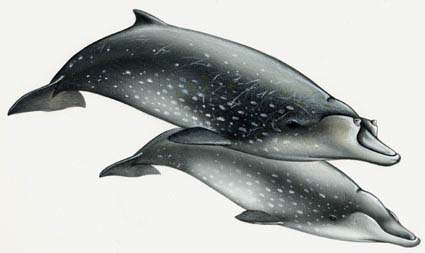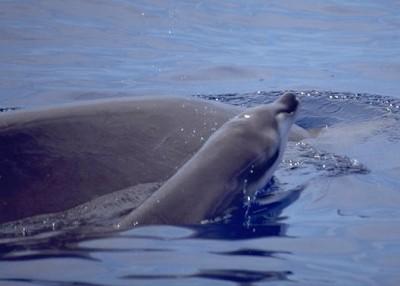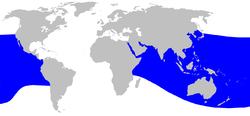Common Name: Blainville’s Beaked Whale
General Description: The head and body of this beaked whale are spindle shaped and strongly compressed at the tail. There is a slight neck depression, and the beak is prominent. Two massive (up to 15 cm high) teeth are present on either side of the lower jaw in males. They are located on prominent raised arches, and may be higher than the forehead. These are not erupted in females. The eyes are moderately large.
Two grooves are present on the throat, forming an open V. The head is often flattened in front of the blowhole.
The males are generally dark overall, and often have white or reddish patches on the head. The females are black or charcoal grey on the back, and slightly lighter or white on the abdomen. Scars usually cover the body, males being more heavily scarred than females.
Little information is available on Blainville’s Beaked Whale. The location of the teeth is unusual even among the beaked whales. The teeth cannot be of much use in catching the slippery squid on which it feeds.

Size: The length attained by this species is 4.7 to 5.2 m. The weight is variously stated to be about 1 and 3.6 tons.
Appearance At Sea: Blainville’s Beaked Whale is the beaked whale most frequently seen in warm tropical waters. It seems to live in small family units of three to six animals.
Before blowing, the whales raise their beaks until the rostrum is clear of water, such that the bulging jaw line can be clearly seen in males. They spend several minutes near the surface, breathing at intervals of 15-20 seconds, and then diving for longer periods.
Stranded Blainville’s Beaked Whales produce sounds described as ‘roars’ and ‘sobbing groans’.\

Found In: Blainville’s Beaked Whale is found in warm temperate and tropical waters, mostly offshore in deep water. They feed mainly on squid.
Records from India: This beaked whale is reported from the Nicobar Islands. It is also recorded from Mauritius and the Seychelles.
World Distribution: This species is the most widely distributed of the genus Mesoplodon. It has been recorded in all the oceans.
Could Be Confused With: Blainville’s Beaked Whale is unmistakable, especially if males of almost any age are present in the group.
Diagnostic Features: At sea, Prominent beak, bulging jaw line, scarring.
Stranded Specimens: In males, a single pair of gigantic teeth is present 30 cm from the tip of the jaw. Each tooth is almost completely enclosed in a heavy bulge of bone rising from the lower jaw, with only a small portion of the tooth protruding. In females, these teeth are not erupted but the lower jaw still has a marked bulge.



